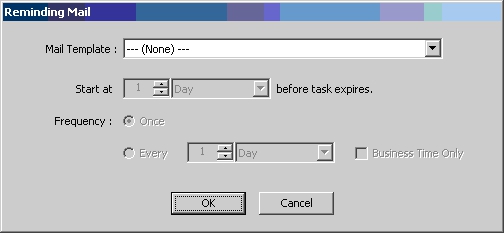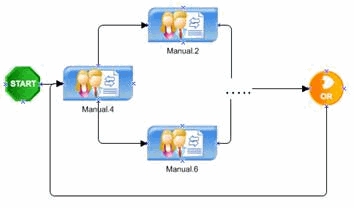AgileWork
This is a generic AgileShape that can be associated with any AgileWork that is registered in AgilePoint Envision. The user will be prompted to select a specific AgileWork when this AgileShape is added to a process template.
The main differences of an AgileWork component as compared to an AgilePart are:
- An AgileWork component must inherit from the WFAgileWork base class.
- An AgileWork component's design-time support is created using the WFAgileWorkDescriptor class. (It is very similar to the WFAgilePartDescriptor class).
- All AgileWorks inherit the following server-side events from the WFAgileWork base class:
AgileWork Properties
| Field Name | Definition |
|---|---|
| (Name) |
Read Only Default value: AgilePart.xxx, AgileWork The display name of the AgileShape. |
| (UID) |
Read Only Default value: AgilePart.xxx or AgileWork The ID that uniquely identifies this AgileShape from all others within the same process template. |
| Description |
Optional A description of the AgileShape. This property is primarily used as a means of recording additional notes, comments, and details about this AgileShape in order to make the process template more understandable to process modelers. |
| Optional |
Default value: False Determines whether the activity represented by this AgileShape can be manually canceled (using AgilePoint Enterprise Manager). This property can be set to the following specific values: |
| TimeSpan |
Default value: 10 Minute(s) Specifies the maximum amount of time that should be allowed for the completion of the activity associated with this AgileShape before it is considered overdue. |
| BusinessTime |
Default value: False Determines whether the time span represents normal time, or business hours only. This property can be set to the following specific values:
|
| Length |
Default value: 10 The number of time units represented by the time span. |
| Time Unit |
Default value: Minute The type of time unit represented by the time span. This property can be set to the following specific values: |
| Work To Perform |
Specifies the name of the manual activity that needs to be performed by the activity's participant(s). The value of this property is used by the AgilePoint Task Manager Web Part (for SharePoint portals) and by the AgilePoint Task List Web Control (for ASP.NET applications) to determine the URL of the Web page that contains the UI for the manual activity represented by this AgileShape. However, the exact effects of this property (and the valid values) vary depending on which type of process template the AgileShape is used in. For Generic process templates: When used in Generic process templates, this property refers to the name of an ASP.NET Web form in the ASP.NET application associated with the process. It is the page's file name without the file extension (.aspx). However, if the page resides in a subfolder of the application, you would also include the folder name(s). E.g. If the URL of your ASP.NET application is: http://www.mycompany.com/MyApp/ and the URL of the Web page is: http://www.mycompany.com/MyApp/My Page.aspx then you would configure the value of this property as: My Page However, if the URL of your ASP.NET application is: http://www.mycompany.com/MyApp/ and the URL of the Web page is: http://www.mycompany.com/MyApp/pages/admin/My Page.aspx then you would configure the value of this property as: pages/admin/My Page For Microsoft InfoPath process templates: When used in Microsoft InfoPath process templates, this property refers to the Form View of the InfoPath form associated with this AgileShape. The names of the available form views will automatically be listed in the drop-down list for this property (as shown below).  For Microsoft SPDoc process templates: When used in Microsoft SPDoc process templates, this property refers to the name of an ASP.NET Web form located under the "/_layouts/AP/" subfolder of the document library's team site. For Microsoft SPDoc process templates associated with an AgilePoint Document Control Library (i.e. a document library created using the "STSAP" SharePoint Team Site template), the following values can be used by default:
|
| Activity Entry Email |
Optional The name of an Email Template that should be used to generate an automatic email notification when this AgileShape is entered at runtime. If this property is left blank, then an email notification will not be sent automatically when the AgileShape is entered at runtime. If this property is not blank, then an email notification will be dynamically constructed and sent at runtime (when the AgileShape is entered) using the specified Email Template. |
| Activity Exit Email |
Optional The name of an Email Template that should be used to generate an automatic email notification when this AgileShape is exited at runtime. If this property is left blank, then an email notification will not be sent automatically when the AgileShape is exited at runtime. If this property is not blank, then an email notification will be dynamically constructed and sent at runtime (when the AgileShape is exited) using the specified Email Template. |
| Task Reassigned Email |
Optional The name of an Email Template that should be used to generate an automatic email notification when this AgileShape is reassigned at runtime. If this property is left blank, then an email notification will not be sent automatically when the AgileShape is reassigned at runtime. If this property is not blank, then an email notification will be dynamically constructed and sent at runtime (when the AgileShape is reassigned to a new participant) using the specified Email Template. |
| Reminder Email |
Optional This property allows the process modeler to configure "reminders" that will notify users (at runtime) based on certain conditions. This property is typically available with AgileShapes that are associated with one or more participants (e.g. Manual and AgileWork AgileShapes). Click the Ellipses button to open the Reminder Email dialog (as shown below). 
This dialog allows the process modeler to choose a specific Email Template that should be used to generate the "reminder" email notification(s). It also allows the process modeler to configure the start time (relative to the AgileShape's expiration) and the frequency of recurrence at which the email notification(s) will be sent. |
| TimeoutEmail |
Optional The name of an Email Template that should be used to generate an automatic email notification when this AgileShape becomes overdue at runtime. If this property is left blank, then an email notification will not be sent automatically when the AgileShape becomes overdue at runtime. If this property is not blank, then an email notification will be dynamically constructed and sent at runtime (when the AgileShape becomes overdue) using the specified Email Template. |
| Max. Participant |
Default value: 1 Specifies how many Participants actually need to be assigned to work on the activity. E.g. If the Participants property is set to a group of users, and Max. Participant is 2, then only 2 users in the group actually need to be assigned to "participate" in the activity when the AgileShape is entered (at runtime). If all users must complete the task, set the value to Maximum. |
| Participants |
Specifies the user(s) that the activity can be assigned to for completion. This property can be set to a specific user, group of users, or a user role. To specify multiple participants, separate the usernames with a semicolon (;). For more information, see Adding Participants to an Activity. |
| Reuse Participant |
Default value: True This property can be set to the following specific values:
|
| Audit Level |
Default value: High This property determines the amount of process related data that is recorded to the workflow database. This property can be set at either the Process Template Properties layer or at the individual AgileShape layer. This property allows you to control the level of granularity in terms of the amount of process related data that is recorded to the workflow database. This property can be set to the following specific values:
Audit level at Process Template level
|
| Auto Complete |
Default value: False This property can be set to the following specific values:
|
| Debug |
Default value: False This property enables you to monitor the performance of and troubleshoot a particular AgileShape. Setting this property to True adds information to the AgilePoint Server log regarding this shape – for example, data being passed to or from the shape, or database connection information. You can use this data to monitor the performance of particular AgileShapes. This property can be set to the following specific values:
|
| Priority |
Default value: Normal This property indicates the priority level for the task to be shown at runtime in the user's task list. This property can be set to the following specific values, or you can type over the value to set a custom attribute:
|
| SessionMode |
Default value: Single This property can be set to the following specific values:

|
| Wait All Incoming |
Default value: False When an AgileShape has multiple direct predecessors (i.e. it has multiple In-Connectors leading directly from other AgileShapes), this property determines how many of the predecessor AgileShapes must be exited (at runtime) before this AgileShape can be entered (at runtime). This property can be set to the following specific values:
|
| Wait Work Performed |
Default value: True This property can be set to the following specific values:
|
| AssemblyName |
Read Only Default value: Automatically determined (based upon the user's input) when the AgileShape is first added to the process template. The name of the .NET assembly containing the specific AgilePart component that this AgileShape instance is associated with. |
| ClassName |
Read Only Default value: Automatically determined (based upon the user's input) when the AgileShape is first added to the process template. The fully qualified Type name (including the namespace) of the .NET class (in the .NET assembly specified by the AssemblyName property) that represents the specific AgilePart component that this AgileShape instance is associated with. |
